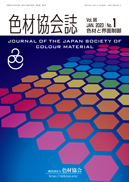
- |<
- <
- 1
- >
- >|
-
Hideki SAKAI, Hirobumi SHIBATA2023 Volume 96 Issue 3 Pages 95
Published: March 20, 2023
Released on J-STAGE: March 31, 2023
JOURNAL FREE ACCESSDownload PDF (135K)
-
Shunta IWAKURA, Takuro ITO, Tatsunori SAKAI, Kayano SUNADA, Yasuhide M ...2023 Volume 96 Issue 3 Pages 96-103
Published: March 20, 2023
Released on J-STAGE: March 31, 2023
JOURNAL FREE ACCESS
Supplementary materialSingle-phase powders of γ-Ce2Mo3O13, Ce8Mo12O49, and Ce2Mo4O15 were prepared using the solid-phase method. Then, the antiviral activity of these powders against the non-enveloped virus bacteriophage Qβ and the enveloped virus bacteriophage Φ6 were evaluated. Moreover, H2O2 assay and catalase inactivation test were performed. Regarding the antiviral activity of the prepared samples, the activity against bacteriophage Φ6 was higher than the activity against bacteriophage Qβ. The antiviral activity order for bacteriophage Φ6 was correlated with the amount of H2O2 generated and the catalase inactivation rate. It depended also on the eluted Ce/Mo ratio. These results imply that the antiviral activity on bacteriophage Qβ is influenced by neutralization of the negative charge of capsid by rare earth ions and by adsorption of heteropolyacids to specific sites of the virus. Results suggest that the oxidation reaction of Ce (IV) or of the H2O2, and the adsorption of heteropolyacids formed by Ce and molybdate ions affect the antiviral activity against bacteriophage Φ6. Among the compounds examined this time, γ-Ce2Mo3O13 exhibited the highest antiviral activity against bacteriophage Φ6.
View full abstractDownload PDF (6094K) -
Oil-Gelling Ability of the Mixture of Plant-Derived Highly Purified Paraffin Wax and Botanical WaxesKirara NAGATSU, Chihiro IZAWA, Masashi SHIBATA2023 Volume 96 Issue 3 Pages 104-107
Published: March 20, 2023
Released on J-STAGE: March 31, 2023
JOURNAL FREE ACCESSOil gels composed of oils and waxes are used in stick cosmetics. Recently, modification of petroleum-derived waxes to botanical waxes has become desirable; however, the gel hardness of these gels is insufficient. Therefore, to improve the gel hardness of rice paraffin wax (RP-wax), a highly purified botanical wax, the mixing effect with other botanical waxes, namely carnauba wax and rice bran wax, was investigated. RP-wax has a lower gel hardness than petroleum-derived paraffin waxes because of the formation of large plate crystals in the gel. The gel hardness of carnauba wax is very low owing to the existence of spherical clusters composed of small crystallites in the gel. However, when RP-wax was mixed with 20% carnauba wax, its gel hardness significantly improved. This was due to the size reduction of plate crystals in the gel and the disappearance of the spherical clusters derived from carnauba wax. However, rice bran wax did not produce a similar effect.
View full abstractDownload PDF (789K) -
Sara SAIJO, Masashi SHIBATA, Chihiro IZAWA2023 Volume 96 Issue 3 Pages 108-112
Published: March 20, 2023
Released on J-STAGE: March 31, 2023
JOURNAL FREE ACCESSTo increase the amount of ferulic acid adsorbed on a ferulic acid-silica composite, which is expected to be applied as a UV-protection material, a method for preparing the composite by using an anti-solvent precipitation method was investigated. Mesoporous silica was dispersed in a 50% ethanol solution of ferulic acid, and water was added as the poor solvent; the resultant adsorption amount was five times higher with water added. The diffuse reflectance spectrum of the prepared ferulic acid-mesoporous silica composite only showed the absorption of ultraviolet light and no absorption of visible light. This confirmed that ferulic acid was adsorbed into the pores of the powder, and not on its surface.
View full abstractDownload PDF (939K) -
Miki AKATSUKA, Kumiko TASAKI, Yoshiumi KOHNO, Masashi SHIBATA2023 Volume 96 Issue 3 Pages 113-117
Published: March 20, 2023
Released on J-STAGE: March 31, 2023
JOURNAL FREE ACCESSA solution composed of 3-deoxyanthocyanidin extracted from sorghum shell, a weakly acidic buffer solution, and dipropylene glycol showed photochromism. For the industrial use of this natural photochromic dye, solidification or pigmentation is necessary. However, there is a concern that the photochromic performance may deteriorate due to the change in solution composition through the process. In this study, we investigated the effect of composition shifts of the dye solution, namely solvent volatilization, water loading, and acid, base or polyvalent cation contamination on the photochromic performance.
Even when most of the water evaporated from the dye solution, neither the pH nor the photochromic properties of the solution changed. In contrast, when a large amount of water, acid, or base was mixed into the solution, the pH of the solution shifted, and deterioration in the photochromic performance was observed. Additionally, a small amount of polyvalent cations contaminating the dye solution shifted the solution to a more acidic solution, and the photochromic performance decreased. In this case, it was possible to recover the photochromic performance by altering the buffer solution used for the solution preparation to a slightly more basic solution.
View full abstractDownload PDF (1178K)
-
Chiaki TANUMA2023 Volume 96 Issue 3 Pages 118-122
Published: March 20, 2023
Released on J-STAGE: March 31, 2023
JOURNAL RESTRICTED ACCESSPrinting systems for manufacturing, such as industrial printers and 3D printers using inkjet technology, are being actively proposed and developed. In such applications, a print head that prints a variety of inks according to the printing specifications is indispensable. Piezoelectric inkjet printheads have been developed to meet printing requirements through the development of various technologies such as improvement of piezoelectric materials, development of manufacturing processes, and development of control methods.
This paper describes the technologies that have supported the evolution of piezoelectric inkjet printheads, including the fundamentals of piezoelectric materials, head structure types and features, and head fabrication process features.
View full abstractDownload PDF (2539K)
- |<
- <
- 1
- >
- >|